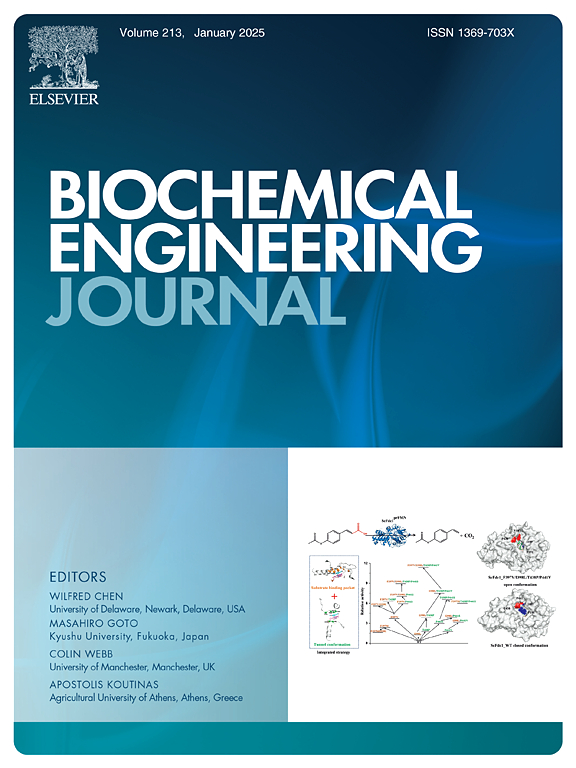Sustainable intensified conversion of waste corn cob to 5-HMF by synergistic action between infrared radiation and cellulase grafted nano-titania-silica bio-photocatalyst
IF 3.7
3区 生物学
Q2 BIOTECHNOLOGY & APPLIED MICROBIOLOGY
引用次数: 0
Abstract
This study reports the pioneering investigation into the synergistic effects of nano-silica-titania immobilized cellulase bio-photocatalyst and visible near-infrared radiation (VIS-NIR) on the intensification of 5-hydroxymethylfurfural (5-HMF) synthesis from delignified corn cob (DCC). A nano-bio-photocatalyst, silica/titania-cellulase (ST-C),was engineered where nano-titania-silica core-shell spheres were synthesized and conjugated with Aspergillus niger derived cellulase enzyme. With a band gap of 2.83 eV, the optimized ST-C exhibited its potential for enhanced bio-photocatalytic efficacy in 5-HMF synthesis via bio-photochemical conversion (BPC) of DCC in a quartz iodine irradiated self-vibrating batch bioreactor (QIISBR) (100 W,visible range:380–700 nm).The synergistic effect between VIS-NIR of QIISBR and the prepared ST-C bio-photocatalyst was evident from the enhanced 5-HMF yield(74.24 mol%) compared to dark run (69.3 mol%) at the optimal 60°C BPC temperature, 1 wt% bio-photocatalyst concentration, 60 min reaction time, 30 w/w Biomass-to-Water ratio as determined by Taguchi Structured Orthogonal Design (TSOD). The VIS-NIR system also offered 68.5 % energy savings compared to dark run. Remarkably,the immobilized enzyme preserved 93 % of its initial activity after nine consecutive uses, showcasing its high operational stability and recyclability attributes. The Life Cycle Sustainability Evaluation (LCSE) revealed reduction in environmental burdens, marked by 69.23 % decrease in Carbon Footprint,45.8 % decline in Human Toxicity Potential,50.1 % reduction in Water Consumption Potential compared to conventional process.The developed process demonstrating synergistic application of VIS-NIR and bio-photocatalyst could procreate a greener pathway through sustainable valorization of lignocellulosic biomass towards synthesis of 5-HMF and similar platform chemicals.
红外辐射与纤维素酶接枝纳米二氧化钛生物光催化剂协同作用下废玉米芯持续强化转化为5-羟甲基糠醛
本研究首次研究了纳米二氧化硅-二氧化钛固定化纤维素酶生物光催化剂和可见光近红外辐射(VIS-NIR)对脱木质素玉米芯(DCC)合成5-羟甲基糠醛(5-HMF)的协同效应。以黑曲霉纤维素酶为载体,合成纳米二氧化钛/二氧化钛-纤维素酶(ST-C)。优化后的ST-C带隙为2.83 eV,在石英碘辐照自振动间歇式生物反应器(QIISBR)(100 W,可见光范围380 ~ 700 nm)中通过DCC的生物光化学转化(BPC)合成5-HMF具有增强的生物光催化效果。采用田口结构正交设计(TSOD)确定的最佳BPC温度为60°C,生物光催化剂浓度为1 wt%,反应时间为60 min,生物质水比为30 w/w时,与暗反应(69.3 mol%)相比,QIISBR的VIS-NIR与制备的ST-C生物光催化剂之间的协同效应明显,5-HMF产率提高了74.24 mol%。与暗运行相比,VIS-NIR系统还提供了68.5 %的节能。值得一提的是,该固定化酶在连续使用9次后仍保持了93% %的初始活性,具有较高的操作稳定性和可回收性。生命周期可持续性评价(LCSE)表明,与传统工艺相比,环境负担减少了69.23% %,人类毒性潜力下降了45.8% %,水消耗潜力降低了50.1% %。开发的过程表明,VIS-NIR和生物光催化剂的协同应用可以通过木质纤维素生物质的可持续增值来合成5-HMF和类似的平台化学品,从而产生更绿色的途径。
本文章由计算机程序翻译,如有差异,请以英文原文为准。
求助全文
约1分钟内获得全文
求助全文
来源期刊

Biochemical Engineering Journal
工程技术-工程:化工
CiteScore
7.10
自引率
5.10%
发文量
380
审稿时长
34 days
期刊介绍:
The Biochemical Engineering Journal aims to promote progress in the crucial chemical engineering aspects of the development of biological processes associated with everything from raw materials preparation to product recovery relevant to industries as diverse as medical/healthcare, industrial biotechnology, and environmental biotechnology.
The Journal welcomes full length original research papers, short communications, and review papers* in the following research fields:
Biocatalysis (enzyme or microbial) and biotransformations, including immobilized biocatalyst preparation and kinetics
Biosensors and Biodevices including biofabrication and novel fuel cell development
Bioseparations including scale-up and protein refolding/renaturation
Environmental Bioengineering including bioconversion, bioremediation, and microbial fuel cells
Bioreactor Systems including characterization, optimization and scale-up
Bioresources and Biorefinery Engineering including biomass conversion, biofuels, bioenergy, and optimization
Industrial Biotechnology including specialty chemicals, platform chemicals and neutraceuticals
Biomaterials and Tissue Engineering including bioartificial organs, cell encapsulation, and controlled release
Cell Culture Engineering (plant, animal or insect cells) including viral vectors, monoclonal antibodies, recombinant proteins, vaccines, and secondary metabolites
Cell Therapies and Stem Cells including pluripotent, mesenchymal and hematopoietic stem cells; immunotherapies; tissue-specific differentiation; and cryopreservation
Metabolic Engineering, Systems and Synthetic Biology including OMICS, bioinformatics, in silico biology, and metabolic flux analysis
Protein Engineering including enzyme engineering and directed evolution.
 求助内容:
求助内容: 应助结果提醒方式:
应助结果提醒方式:


